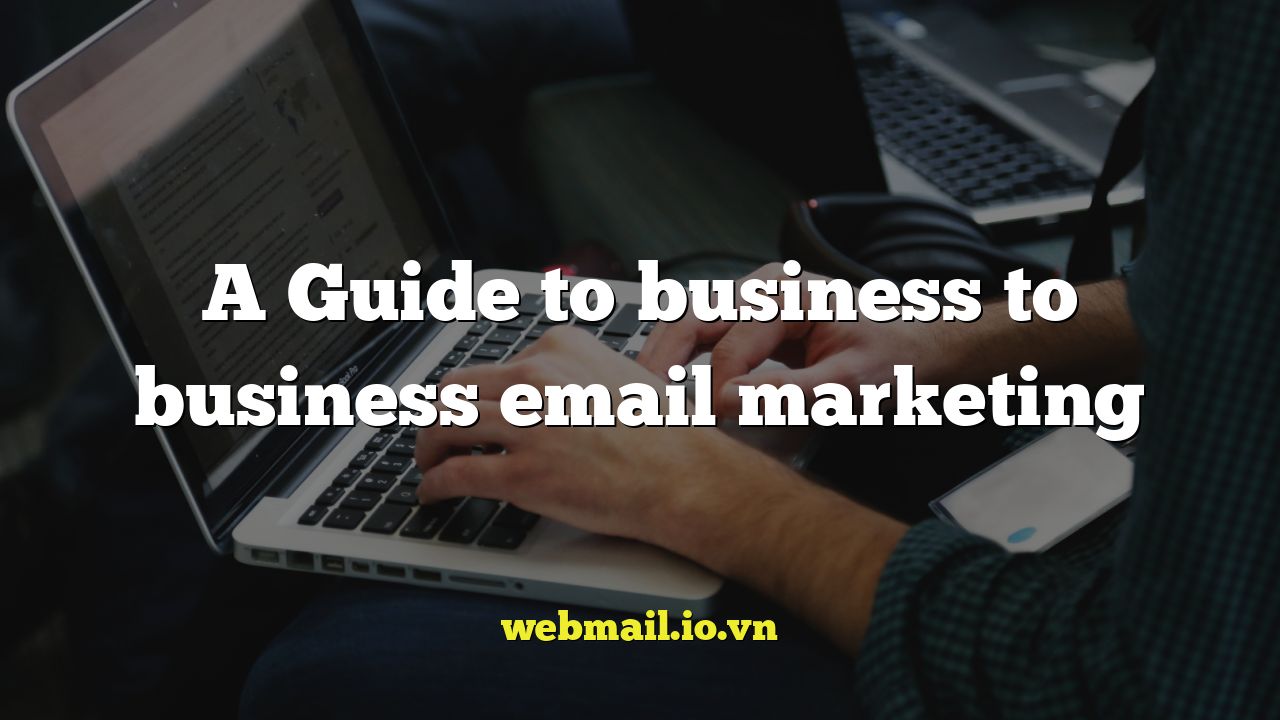
A Guide to Business to Business Email Marketing
Introduction to B2B Email Marketing
Business to Business (B2B) email marketing is a strategic approach to reaching out to other businesses, with the goal of generating leads, nurturing relationships, and ultimately driving sales. Unlike Business to Consumer (B2C) email marketing, which often focuses on immediate purchases and emotional appeals, B2B email marketing emphasizes providing value, building trust, and addressing specific business needs. It’s a long-term game that requires a tailored approach, focusing on education, thought leadership, and building mutually beneficial partnerships.
Building Your B2B Email List
A high-quality email list is the foundation of any successful B2B email marketing campaign. Building this list requires a strategic approach focused on attracting and engaging potential clients.
Methods for Building a B2B Email List
There are several effective ways to build a strong B2B email list:
- Offer valuable resources: Create high-quality content such as ebooks, white papers, webinars, and case studies that address the pain points of your target audience. Gate these resources behind a form that requires email registration.
- Website opt-in forms: Strategically place opt-in forms on your website, including on your homepage, blog, and landing pages. Clearly communicate the value of subscribing.
- Networking events and trade shows: Collect email addresses at industry events by offering a sign-up sheet or using a lead capture app.
Segmentation Strategies
Segmentation is crucial for sending relevant and targeted emails. Consider segmenting your list based on:
- Industry: Tailor your messaging to address the specific challenges and opportunities within different industries.
- Company size: Small businesses have different needs than large enterprises.
- Job title: Target different messaging to decision-makers versus influencers.
Crafting Compelling B2B Email Content
The content of your emails is paramount to success. B2B audiences are often bombarded with emails, so yours needs to stand out and provide real value.
Email Subject Lines
The subject line is the first impression. Keep it concise, clear, and intriguing. Consider these tips:
- Use action verbs: Start with words like “Discover,” “Learn,” or “Improve.”
- Personalize the subject line: Use the recipient’s name or company name when possible.
- Create a sense of urgency: But avoid being overly salesy or spammy.
Email Body
The body of your email should be well-structured and easy to read. Focus on providing value and addressing the recipient’s needs.
Content Pillars for B2B Emails
Base your content around these core themes:
- Thought leadership: Share your expertise and insights on industry trends.
- Problem-solving: Offer solutions to common business challenges.
- Product updates and announcements: Keep your audience informed about new features and services.
Email Marketing Automation for B2B
Email marketing automation is essential for scaling your B2B efforts. It allows you to send the right message to the right person at the right time, without manual intervention.
Workflow Examples
Here are some common B2B email marketing automation workflows:
- Welcome series: A series of emails sent to new subscribers to introduce your company and its offerings.
- Lead nurturing campaign: A series of emails designed to move leads through the sales funnel by providing valuable content and building trust.
- Re-engagement campaign: A series of emails sent to inactive subscribers to encourage them to re-engage with your brand.
Choosing the Right Email Marketing Platform
Select an email marketing platform that meets your specific B2B needs. Consider factors such as:
- Segmentation capabilities: Can you easily segment your list based on various criteria?
- Automation features: Does the platform offer robust automation workflows?
- Integration with CRM: Can the platform integrate with your CRM system to track leads and sales?
Measuring and Analyzing Your Results
Tracking and analyzing your email marketing results is crucial for optimizing your campaigns and improving your ROI.
Key Metrics to Track
Monitor these key metrics:
- Open rate: The percentage of recipients who opened your email.
- Click-through rate (CTR): The percentage of recipients who clicked on a link in your email.
- Conversion rate: The percentage of recipients who completed a desired action, such as filling out a form or making a purchase.
- Bounce rate: The percentage of emails that could not be delivered.
- Unsubscribe rate: The percentage of recipients who unsubscribed from your list.
A/B Testing
Use A/B testing to experiment with different subject lines, email content, and calls to action. Analyze the results and use them to improve your future campaigns.
Legal Considerations
Compliance with email marketing regulations is essential. Failure to comply can result in significant penalties.
CAN-SPAM Act
The CAN-SPAM Act is a US law that sets the rules for commercial email and requires businesses to provide recipients with an easy way to unsubscribe.
GDPR
The General Data Protection Regulation (GDPR) is a European Union law that protects the personal data of EU citizens. If you are marketing to businesses in the EU, you need to comply with GDPR.
B2B Email Marketing Best Practices
To maximize the effectiveness of your B2B email marketing campaigns, follow these best practices:
- Personalize your emails: Use the recipient’s name and company name whenever possible.
- Provide value: Focus on providing valuable content that addresses the recipient’s needs.
- Keep your emails concise and easy to read: Use clear and concise language.
- Use a clear call to action: Tell the recipient what you want them to do.
- Test your emails: Before sending your emails, test them on different devices and email clients.
- Monitor your results: Track your key metrics and use them to improve your future campaigns.
Conclusion
B2B email marketing is a powerful tool for generating leads, nurturing relationships, and driving sales. By following the tips and best practices outlined in this guide, you can create effective email marketing campaigns that deliver real results for your business. Remember to focus on providing value, building trust, and tailoring your approach to the specific needs of your target audience. Continuously analyze your results and adapt your strategies to stay ahead of the curve and maximize your ROI.